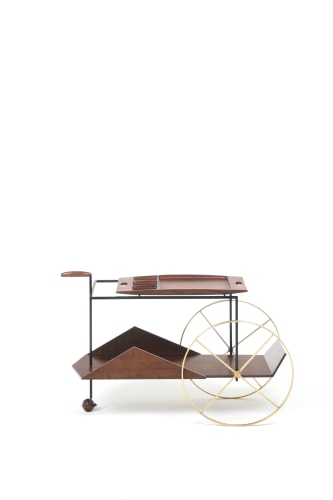A house offers countless clues to the spirit of its inhabitants. Every object it shelters points to choices, memories, and relationships established within: the arrangement of sofas, chairs, and dining tables reveals habits—such as how often the residents receive guests; the books on the shelves and the paintings that decorate the walls present their interests and trajectories; the framed photographs tell stories of bonds and generational memories; the placement of an armchair or a desk may indicate where someone worked or shaped intimate thoughts.
In Fantasmagoria, an exhibition organized in collaboration between Carlos/Ishikawa, Etel, and Almeida & Dale, pieces of the original furniture from this house—where Jorge Zalszupin lived with his family for almost six decades—enter into dialogue with works by internationally recognized artists. It is as if we were visiting a home whose residents had just stepped out: the air still carries echoes of past conversations; the wood’s shine retains the warmth of the bodies once present; and each piece of furniture seems to hold the tactile memory of those who handled it.
The modernist residence inhabited by Zalszupin here becomes a living body, a silent witness and stage for interactions between the memories it holds and those evoked in the works of Marlene Almeida, Korakrit Arunanondchai, Steve Bishop, Josiane M.H. Pozi, and Issy Wood. The house’s materials and finishes—balancing organic forms with constructive precision—reflect the architect’s lived experiences, fusing Scandinavian tradition with Brazilian modernism. Much like the furniture on display, they bear simultaneous witness to the history of design in the country and to the intimate life of one of Brazil’s greatest icons of design and architecture. Here, objects function as portals materializing time and memory: personal experiences that, at the same time, resonate with an entire era and remain alive today.
A similar relationship occurs in the paintings of Issy Wood. In them, objects seem endowed with their own agency. On canvases where the body is more suggested than depicted, domestic elements condense relationships, desire, longing, and the tensions of consumption—denaturalizing the banality of everyday gestures.
Intimacy emerges as an ambiguous and conflict-laden field in the work of Josiane M.H. Pozi, whose video transports us to a moment both trivial and sharply personal, confronting us with the fragility of emotions on the threshold between solitude and loneliness. The dimming of lights and the memories left behind in communal spaces are explored by Steve Bishop in a nostalgic and melancholic video that addresses absence and permanence, and the tension between inhabited space and natural forces.
Reminding us of the stone beneath our feet and the wood above our heads, Marlene Almeida leads us back to the primordial stages of matter. She points to the living—yet often forgotten—substrate on which we build our foundations, imbued with intangible temporal layers. In her practice, spaces become inherently steeped in history from their most primary stages.
This is not, therefore, a haunting phantasmagoria, but rather an invitation to recognize the life that persists in every corner—the memory and echoes of the past that continue to resound. As Korakrit Arunanondchai reminds us, ghosts accompany us and may serve as guides, leading us through the material and immaterial passages we inhabit in an age marked by virtuality and the datafication of subjects.
Between paintings, sculptures, and videos, the works gathered here weave together memory and matter in ways that resist the erosion of time. Casa Zalszupin thus becomes a resonant body, where absence appears as a pulsating fragment of life.
Visits by reservation only: book your visit
